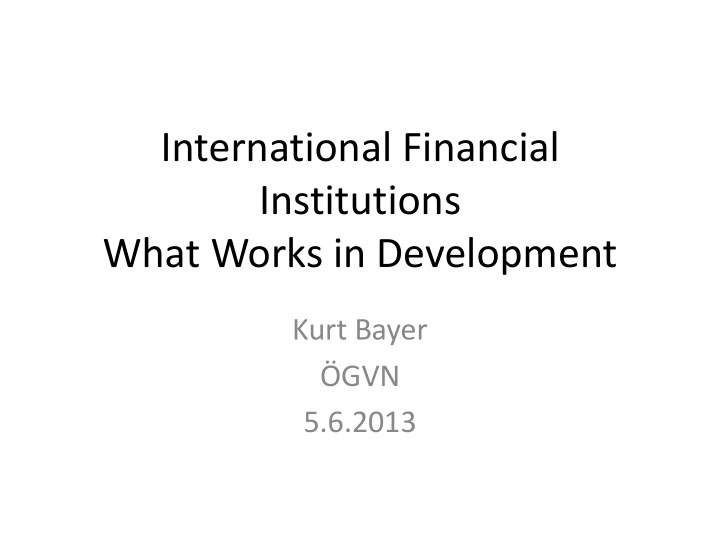



International Financial Institutions What Works in Development Kurt Bayer ÖGVN 5.6.2013
ORIGINS and PURPOSE • As part of the new World Order, at the Bretton Woods Conference in 1944, the International Monetary Fund and the International Bank for Reconstruction and Development (World Bank) were founded. • IMFs role is short-term help for Balance of Payments problems, World Bank for long-term development aspects, Trade organization was planned, but only implemented later (GATT). • Both tie financial help to “ conditionality ”
Other Banks • During the 60 ’ s and 70 ’ s the African, Asian, and Inter- American Development Banks were founded, with similar agendas as World Bank, but regional focus. • In 1991, after the fall of the Iron Curtain, the European Bank for Reconstruction and Development (EBRD) was founded, with the purpose to support the development of a sustainable market economy and to support democratization. • A number of other regional banks has sprung up.
INSTRUMENTS OF DEV. BANKS • Grants: free money for mainly social and institutional purposes • Loans: charging of interest (market or concessional) in order to convey that donor money is scarce, that need to repay helps to select those projects in recipient countries which generate the highest benefits, market discipline • Equity, guarantees, funds, etc. all financial instruments • Technical Assistance, Advice
FISCAL FOOTPRINT OF DEVELOPMENT BANKS • In 2012 World Bank invested 35.3 bn $, IFC 15 bn $, IDB 12.3 bn $, ADB 5.7 bn $, AsDB 21.6 bn $, EBRD 8.9 bn EURO • Together, this amounts to 91 bn EUR; this is about 0.4% of the GDP of developing and emerging countries, about 1.5% of their total (public and private) investments. • Thus: quantitative footprint small, quality of intervention counts
THE WORLD BANK ANNUAL REPORT 2012 IBRD and IDA Lending by Theme │ Fiscal 2012 Share of total lending of $35.3 Billion Urban Economic Development Management Environmental 12% 4% and Natural Trade and Resources Integration Management 5% 11% Social Protection Financial and and Risk Private Sector Management Development 10% 13% Social Development, Gender, and Inclusion 4% Human Development Rural 14% Development Public Sector 15% Rule of Law Governance <1% 11% 6
THE WORLD BANK ANNUAL REPORT 2012 IBRD Top Ten Borrowers │ Fiscal 2012 millions of dollars 3 500 3 000 2 500 2 000 1 500 1 000 500 0 7
THE WORLD BANK ANNUAL REPORT 2012 IDA Top Ten Borrowers │ Fiscal 2012 millions of dollars 3 000 2 500 2 000 1 500 1 000 500 0 8
INSTRUMENT OPTIONS • Budget support – Project finance • Policy performance – individual projects • Privatization - SOE/Cooperatives • Sustainability – Profit motive • Anti-Corruption • Monitoring, performance basis • Evaluation • IMF – Bank coordination
PRIVATE SECTOR BANKS IFC AND EBRD • Both promote private sector development by means of non-concessional (market-rate) loans, equity and guarantees (plus others) • In 2012 IFC invested 12 bn EUR, EBRD 9 bn and activated around 60 bn EUR investments • Project finance, “ sponsored ” by domestic or foreign enterprises • Specificity: long-term finance, higher-risk, technical assistance, more due diligence, activation of private financiers
SECTOR FOCUS IFC/EBRD • IFC focus: Financial institutions (50%), Infrastructure (5%), Consumer/Social Services (9%), Agriculture (7%), Manufacturing (5%), Oil/Mining (3%), Telecoms (2%) • EBRD focus: Financial institutions (32%), Corporates (Agri, Manuf, Services: 28%), Infrastructure (21%), Energy (20%) • Now all regional banks have also started private-sector interventions
FINANCE SECTOR • Financial sector instrumental for private sector development, thus focus • Problems: frequently foreign takeovers or creations, focus on state-connected and large enterprises, thus lack of SME and micro-credit • High absorption of scarce funds by FI as result of the crisis • Lack of banking knowhow, other sectors • Hard-currency loans, lack of domestic financial markets
INFRASTRUCTURE • Focus of regional Dev. Banks • Large projects (roads, dams, telecoms) with frequently high social (displacement) and environmental costs; beneficiaries often large and international enterprises • Problems of corruption in procurement • Positive: strong emphasis on municipal infrastructure (water, wastewater, electricity, mass transport, waste collection, recycling)
MINING, OIL, GAS • Large international projects, high corruption potential • Environmental disruptions • One-sided development (Africa, Mongolia, Kazakhstan, Turkmenistan, Azerbaidjan) • Energy: all do energy efficiency, but in general new supply dominates
GOVERNANCE, CORRUPTION • Legal infrastructure • Procurement • Anti-corruption drive • Training, • High ethical standards within Banks • In WB for a long time, corruption was considered “ internal affair ” • Due diligence, beneficial owner, but • Tax avoidance
CONCLUSION • Western dominance recedes, emerging countries gain vote and voice • Conditionality important, but often not “ adjusted ” • Performance-based instruments, indicators ? • Problems with budget support (monitoring?), easier with project finance, but too piecemeal • “ Bankability ” (efficiency principle) • “ Best practice ” principle, not development-oriented • Banks als “ Learning Institutions ” , so far inadequate • Ideology still “ unfettered market capitalism ” • Governance Problems
Recommend
More recommend